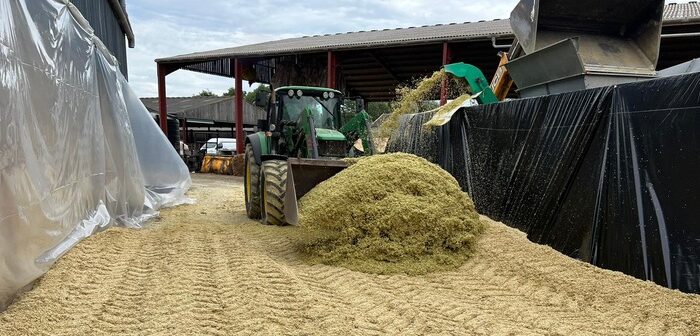Producers growing cereals for animal feed have been advised to harvest their crops at the earliest opportunity, rather than wait for the moisture to come close to 14 per cent.
Wet conditions this harvest have left many cereal crops germinating in the ear or at risk of damage from sooty moulds, rendering them unsaleable for milling or malting.
Feed preservation specialists, Kelvin Cave Ltd, have therefore urged growers to consider using preservation techniques which would allow grain to be harvested at moisture contents of up to 45 per cent and stored with a suitable preservative.
Michael Carpenter, the company’s technical director, says that if the crop will go through a combine, there’s a preservation method which can be employed. This will allow crops to be salvaged for animal feed and prevent any further losses through disease and germination.
“Growers often don’t think of alternative methods of harvesting and preserving their grain, but this year in particular, attempting to dry a crop with a moisture content of more than about 19 per cent is likely to be prohibitively expensive. And once the grain has started to chit, the only feasible option is to crimp and ensile in anaerobic conditions in a clamp or plastic tube,” he says.
The crimping process involves rolling the grain on the day of harvest and applying a suitable preservative.

Michael Carpenter
He says: “There’s a range of preservatives which can be used depending on the moisture content of the sample, whether the grain has started to chit, or the type of storage available.
“A likely recommendation in current conditions would be one of the CrimpSafe preservatives. For instance, CrimpSafe 300 would suit a crop of up to 45 per cent moisture, which has started to chit and turn starch in the grain into sugar in the sprout.”
However, where moisture contents have dropped below 30 per cent and sugars are lower, CrimpSafe Hi-Dry, is more likely to suit the crop.
Non-corrosive acids
“This preservative comprises a blend of non-corrosive acids and preservative salts and will kill yeasts and moulds and turn the grain into a stable feed for long-term, anaerobic storage,” he says.
Despite the salvage operation needed on many farms, crimped grain is actually prized by ruminant nutritionists, who say the moist feed is more digestible and palatable, and can be safely fed in higher quantities than dried rolled grain.
Independent cattle nutritionist, Lizz Clarke, says: “Depending on the size of animal and the type of grain, I would limit intakes of dried cereals to around 4-6kg/head/day during finishing. But because crimp is more easily digested, around 10kg/head/day can be safely fed to similar sized stock.”
If the grain in the crimp has started to chit and turned more of its starch to sugar, she says it can still make highly nutritious feed. However, she recommends testing the crimp’s composition, ideally using wet chemistry, to accurately balance the ration.
She also stresses the need for a preservative that’s proven to stop the growth of yeasts and moulds which could produce mycotoxins.
However, Mr Carpenter acknowledges that not every farmer wants to store moist grain, so offers other alternatives to costly drying.
“Any grain at up to 28 per cent moisture can be treated with Propcorn NC, the non-corrosive form of propionic acid, and stored in a dry grain store,” he says.
“Many farmers are having to think outside the box this year in difficult harvesting conditions,” he says. “However, I have rarely seen a crop which is completely unsalvageable, but I would urge growers to act with speed, as warm weather after the rain will encourage chitting and every day that passes sees a reduction in the value of the crop.”
For more information on options for crops this harvest, please contact Kelvin Cave Ltd on 01458 252281 or technical director, Michael Carpenter on 07817 977701.
Grain treatment and preservation options at different moisture contents
|
Moisture content of crop
|
Preservation options |
| Grain from 25-45% moisture | Grain can be crimped, which involves rolling and treating with CrimpSafe 300 for anaerobic storage in a clamp or plastic tube. The grain is compacted and sheeted like silage, and keeps for over 12 months. Treatment with CrimpSafe 300 controls the fermentation, minimises nutrient losses and maximises protection against spoilage organisms which could cause deterioration of the feed once the clamp or bag is opened at feedout. |
| Grain below 30% moisture | Grain can be crimped and stored anaerobically (as above) with a different choice of preservative when moisture content is lower and there’s insufficient sugar for an effective fermentation. CrimpSafe Hi-Dry includes a range of non-corrosive acids and preservative salts which kill yeasts and moulds and produce a stable animal feed. |
| Grain below 28% moisture | Drier grain can be treated with Propcorn NC if there is no option to clamp or bag and store grain anaerobically. The crop can either be treated whole and rolled as required or rolled and treated in the same process before storing in a dry grain store for over 12 months. This non-corrosive product will not damage milling equipment and improves conditions for the operator over dry grain. |




